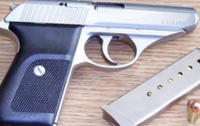
Sig Sauer P320
PHILADELPHIA - A federal immigration agent will have expert testimony to show the allegedly defective design of the Sig Sauer P320 is the reason he was shot in the hip.
The U.S. Court of Appeals for the Third Circuit decided Aug. 1 to let Keith Slatowski take his case against Sig Sauer to trial in Philadelphia federal court, even though experts who back his claims were previously disqualified from speaking to causation.
Sig Sauer faces possibly hundreds of lawsuits alleging its P320 goes off on its own, with Philadelphia firm Salz Mongeluzzi Bendesky behind many of them. The firm filed suit in March on behalf of 22 P320 users in New Hampshire and represents more than 100 plaintiffs in total.
One of them is Slatowski, who sued Sig Sauer in 2021. His case was nearly doomed when Philadelphia federal judge R. Barclay Surrick threw out his experts.
But the Third Circuit revived it, saying Slatowski's own testimony and the experts' views on defective design will be good enough for a jury. It follows the Sixth Circuit in deciding causation experts aren't needed for these cases, though the Tenth Circuit has ruled differently.
"Do not underestimate jurors," Judge Stephanos Bibas' opinion starts.
"Given the other admissible evidence, a jury is will equipped to figure out what caused this gun to fire."
Slatowski is an ex-marine who was undergoing gun training for federal immigration agents when he holstered his gun after firing four magazines and reloading. He says he grabbed the gun by its grip but it fired through his hip and out his thigh.
Bibas called the P320's single-action trigger a "coiled spring in a mousetrap" and noted the gun's internal safety doesn't address the risk someone might graze the trigger and accidentally fire it.
The defective design claims of plaintiffs say very light trigger pressure will set the gun off. Slatowski had two experts, gunsmith James Tertin and firearms instructor William Vigilante.
Defective design claims need proof there were safer alternatives. Neither of the two experts had offered an another design that would have prevented Slatowski's shooting.
Judge Surrick felt this doomed Slatowski's case and awarded summary judgment. The Third Circuit says the experts may still testify that the gun's design was defective.
"That means that experts will explain to the jury the most complicated part of the case: how the P320 and the safeties work," Bibas wrote.
"And a lay juror can understand the rest - namely, what happened that day."
Without a causation expert, though, Saltz Mongeluzzi will have to explain how the trigger was impacted.
"He does not know whether the trigger was depressed by some debris or the holster itself," Bibas wrote.
"And his experts neither considered the gun's holster nor tested how it would have interacted with the gun. Yet all that goes to the strength of his case, not whether a jury could decide for itself how his theory adds up."


